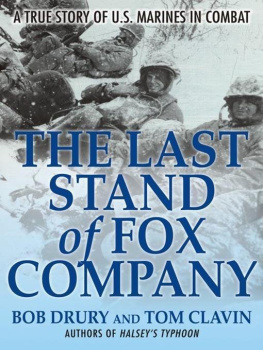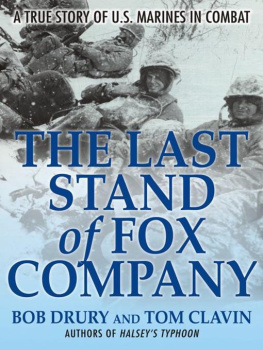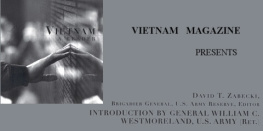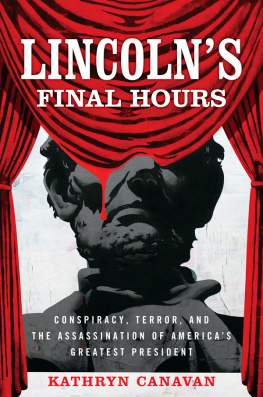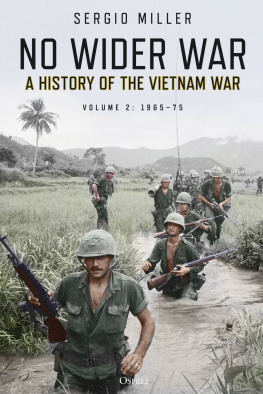Bob Drury - Last Men Out: The True Story of Americas Heroic Final Hours in Vietnam
Here you can read online Bob Drury - Last Men Out: The True Story of Americas Heroic Final Hours in Vietnam full text of the book (entire story) in english for free. Download pdf and epub, get meaning, cover and reviews about this ebook. year: 2011, publisher: Free Press, genre: Detective and thriller. Description of the work, (preface) as well as reviews are available. Best literature library LitArk.com created for fans of good reading and offers a wide selection of genres:
Romance novel
Science fiction
Adventure
Detective
Science
History
Home and family
Prose
Art
Politics
Computer
Non-fiction
Religion
Business
Children
Humor
Choose a favorite category and find really read worthwhile books. Enjoy immersion in the world of imagination, feel the emotions of the characters or learn something new for yourself, make an fascinating discovery.

- Book:Last Men Out: The True Story of Americas Heroic Final Hours in Vietnam
- Author:
- Publisher:Free Press
- Genre:
- Year:2011
- Rating:4 / 5
- Favourites:Add to favourites
- Your mark:
- 80
- 1
- 2
- 3
- 4
- 5
Last Men Out: The True Story of Americas Heroic Final Hours in Vietnam: summary, description and annotation
We offer to read an annotation, description, summary or preface (depends on what the author of the book "Last Men Out: The True Story of Americas Heroic Final Hours in Vietnam" wrote himself). If you haven't found the necessary information about the book — write in the comments, we will try to find it.
Bob Drury: author's other books
Who wrote Last Men Out: The True Story of Americas Heroic Final Hours in Vietnam? Find out the surname, the name of the author of the book and a list of all author's works by series.
Last Men Out: The True Story of Americas Heroic Final Hours in Vietnam — read online for free the complete book (whole text) full work
Below is the text of the book, divided by pages. System saving the place of the last page read, allows you to conveniently read the book "Last Men Out: The True Story of Americas Heroic Final Hours in Vietnam" online for free, without having to search again every time where you left off. Put a bookmark, and you can go to the page where you finished reading at any time.
Font size:
Interval:
Bookmark:
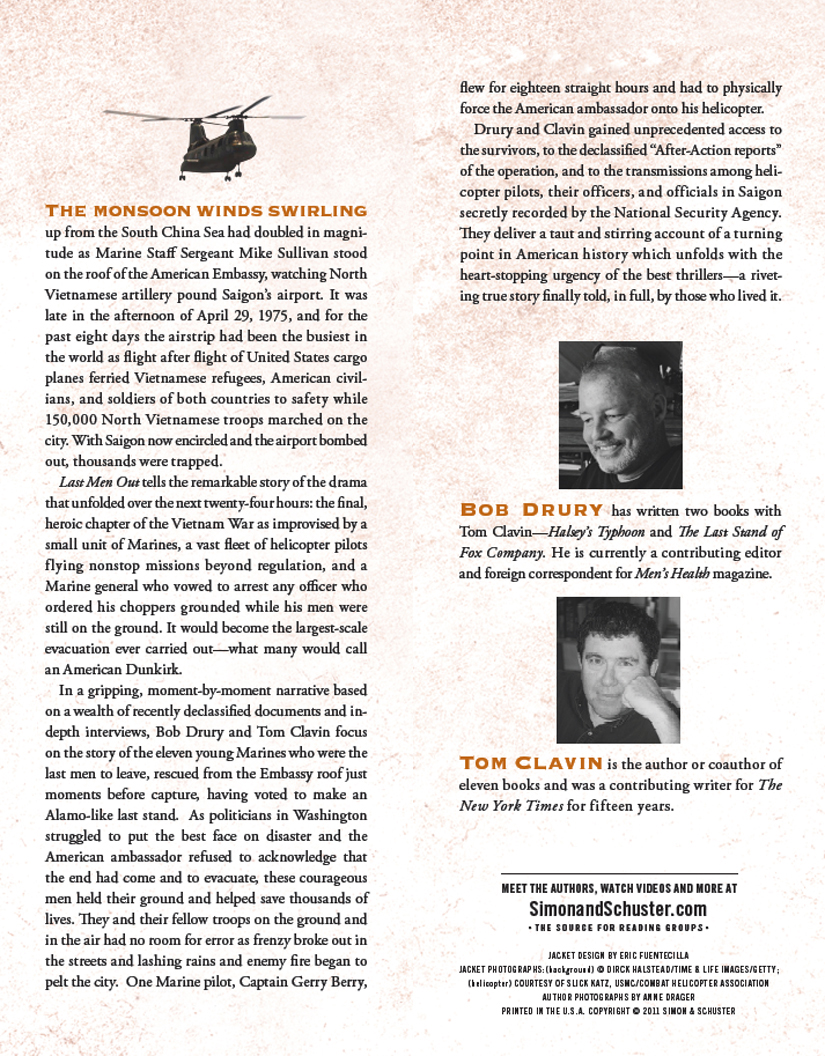

Also by Bob Drury and Tom Clavin
Halseys Typhoon: The True Story of a Fighting Admiral, an Epic Storm, and
an Untold Rescue
The Last Stand of Fox Company: A True Story of U.S. Marines in Combat
Last Men Out


Free Press
A Division of Simon & Schuster, Inc.
1230 Avenue of the Americas
New York, NY 10020
www.SimonandSchuster.com
Copyright 2011 by Bob Drury and Tom Clavin
All rights reserved, including the right to reproduce this book or portions thereof in any form whatsoever. For information address Free Press Subsidiary Rights Department, 1230 Avenue of the Americas, New York, NY 10020
First Free Press hardcover edition May 2011
FREE PRESS and colophon are trademarks of Simon & Schuster, Inc.
The Simon & Schuster Speakers Bureau can bring authors to your live event. For more information or to book an event contact the Simon & Schuster Speakers Bureau at 1-866-248-3049 or visit our website at www.simonspeakers.com .
Designed by Carla Jayne Jones
Manufactured in the United States of America
1 3 5 7 9 10 8 6 4 2
Library of Congress Cataloging-in-Publication Data
Drury, Bob.
Last men out: the true story of Americas heroic final hours in Vietnam / Bob Drury and Tom Clavin.
p. cm.
Includes bibliographical references and index.
1. Vietnam War, 19611975VietnamHo Chi Minh City. 2. Vietnam War, 19611975Evacuation of civiliansVietnamHo Chi Minh City. 3. Vietnam War, 19611975Personal narratives, American. 4. United States. Marine CorpsHistoryVietnam War, 19611975. I. Clavin, Thomas. II. Title.
DS559.9.H58D78 2011
959.7043dc22 2010029333
ISBN 978-1-4391-6101-2
ISBN 978-1-4516-1025-3 (ebook)
For dmcd
rfxd
To my children, Kathryn Hamma Clavin and Brendan Hamma Clavin
TC
U.S. E MBASSY S AIGON 1975
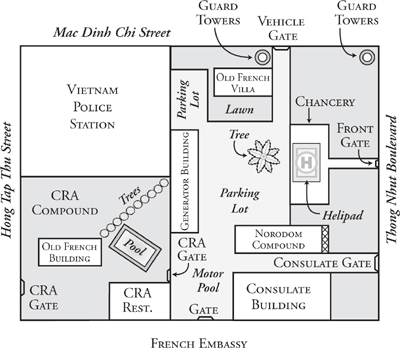
Courtesy of the Fall of Saigon Marine Association, Inc. A California Non-Profit Corp.
U nder the terms of the Paris Peace Accords signed on January 27, 1973, the United States and all foreign governments agreed to withdraw their combat troops from South Vietnam within sixty days; the South Vietnamese government agreed to negotiate with the National Front for the Liberation of Southern Vietnamthe Vietcongtoward a political settlement; and reunification of Vietnam was to be, in the words of the document, carried out step by step through peaceful means. Exempt from the American military drawdown were the detachments of U.S. Marine Corps Security Guards (MSGs) posted at the U.S. Embassy in Saigon and at several U.S. consulates in various provincial capitals.
Less than two years later, the North Vietnamese broke the terms of the accords when, in late 1974, the North Vietnamese Armys chief of staff, General Van Tien Dung, began his push into South Vietnam with the intent of conquering it once and for all. To the surprise of most observers, General Dung marched his army though South Vietnams fir-clad Central Highlands nearly without a fight. Dung had expected to triumph, but not against so little resistance. When U.S. forces pulled out of South Vietnam in 1973, they had left behind for their ally $5 billion worth of military equipment, including hundreds of tanks, 500 fighter bombers, 625 helicopters, and enough arms to equip a 700,000-man army. Thus, the initial ease with which his armies progressed south made Dung wary of a trap. Even when Dungs scout units returned to report that the South Vietnamese Army had, in fact, quit the fight for the Highlands, the general moved forward cautiously. It was only after his divisions captured Pleiku that he, as one of his subordinates wrote, decided to chase them as far as we could and as fast as we could.
Within days of Dungs first attacks, South Vietnams president, Nguyen Van Thieu, recognized that he did not have the manpower to defend the Highlands. Instead, he ordered a defensive perimeter formed along the northern border of Da Nang in preparation for a counterattack, sacrificing the ancient city of Hue in the process. But Thieu had not counted on his army collapsing in on itself like a black hole. As Dungs divisions pressed onward, thousands of mauled Army of the Republic of Vietnam (ARVN) soldiers surrendered or deserted. For those remaining, the orderly withdrawal to Da Nang became a mass exodus, the poets rueful Convoy of Tears.
Ill-disciplined and starving South Vietnamese foot soldiers, many of them abandoned by their commanders, joined terrified throngs of civilians fleeing south. They plundered hamlet after hamlet, clogging roads, raping women, and stealing vehicles. Within days Da Nang was transformed from a once-thriving port city into an armed and desperate refugee camp seething with resentmentagainst the North Vietnamese, against Thieu and his cronies, against the U.S. allies who had abandoned them. In the minds of the 1 million Vietnamese overflowing Da Nang, hate and fear had replaced faith and hope.
On March 29, 1975, artillery shells began falling on Da Nang, in central Vietnam, as 35,000 North Vietnamese Army (NVA) troops prepared to attack. It was not necessary. Panic had done their job for them. Two days earlier, plane and helicopter airlifts had been cancelled when American pilots reported taking withering fire from rogue ARVN units; now these same South Vietnamese soldiers turned their guns on civilians as the latter clawed to reach rescue ships. Women, children, and the elderly were trampled in the rush to the sea. Fishing boats packed with civilians were confiscated by South Vietnamese soldiers, who tossed their countrymen overboard before shooting it out among themselves for the precious berths.
The six U.S. Marines detached to the Da Nang consulate, attempting to help people board at the docks, watched in horror as mothers who did manage to reach the waters edge set their babies adrift in small pails, hoping the tide would carry them out to boats, or toss them at already-moving barges. Most fell short and were drowned. One Marine witnessed a South Vietnamese Army officer shove women and children into the space between the dock and a boat, where they were crushed against the pilings as he scrambled aboard. Another Marine noticed several elderly Vietnamese disappear beneath a sea of bodies in an overflowing barge. By the time he dragged them out from the pile, they had been smothered to death.
That night, a deadly face-off between the Da Nang consulates MSGs and an ARVN company was narrowly averted when the Marines, surrounded by their erstwhile allies, joined the civilian consulate staff hiding in the back of a stolen garbage truck that made its way to the docks, from where they escaped on a leaky barge.
The final blow came when Thieus top commander in Da Nang, Lieutenant General Ngo Quang Truong, abandoned his post to swim for the last U.S. naval vessel sailing from port. One hundred thousand of Truongs troops surrendered. With Da Nang gone, the southern coastal provinces soon followed. Within weeks, the North Vietnamese and their Vietcong comrades surrounded the capital city of Saigon and prepared to invade. For all intents and purposes, the long war in Vietnam was about to come to an end.
Next pageFont size:
Interval:
Bookmark:
Similar books «Last Men Out: The True Story of Americas Heroic Final Hours in Vietnam»
Look at similar books to Last Men Out: The True Story of Americas Heroic Final Hours in Vietnam. We have selected literature similar in name and meaning in the hope of providing readers with more options to find new, interesting, not yet read works.
Discussion, reviews of the book Last Men Out: The True Story of Americas Heroic Final Hours in Vietnam and just readers' own opinions. Leave your comments, write what you think about the work, its meaning or the main characters. Specify what exactly you liked and what you didn't like, and why you think so.

